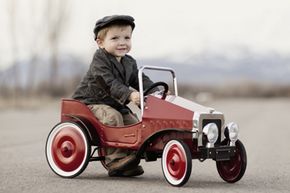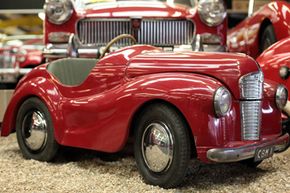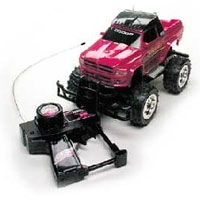They say that the first automobile race happened as soon as the second car was built, and it seems that pedal cars came along right after that. Herrs Benz and Daimler filed for their automobile patents in 1886, and the first pedal-car toys were available in the 1890s. And just like real cars, pedal cars were spendy, meaning only well-to-do families had either a newfangled horseless carriage or a pedal car for the kiddies. But in the 1950s and 1960s, as the middle class got some cash, and their kids perfected the art of whining, pedal cars became wildly popular.
For nearly 80 years, pedal cars were built on wooden chassis' with steel frames, which made them sturdy, heavy and durable. Some of these cars can last for decades, and if you've got the scratch to buy a vintage pedal car at an auction, they're perfectly usable. But in the 1970s, manufacturers started using cheap-and-easy plastic for pedal cars — and everything else, too. The end result was significantly lighter pedal cars — vehicles that were a lot easier for little legs to maneuver.
Advertisement
Which brings us (finally, right?) to the safety issue. Pedal cars are pretty dang safe, really. Most manufacturers recommend that peddlers be 3 to 5 years old. Any kid with long enough and strong enough legs (along with the cognitive development to not run into trees or other kids) can work a pedal car. If a kid can steer and pedal at the same time, bonus! He's a regular pint-sized Richard Petty. Pedal cars kick-it-old-school, with no electric parts (no battery) and they have a low center of gravity, too.
But as we all know, everything in the world is potentially dangerous and a lawsuit waiting to happen. To lessen your chances of injury or lawsuits, we'll cover some basic safety tips on the next page.
Advertisement




